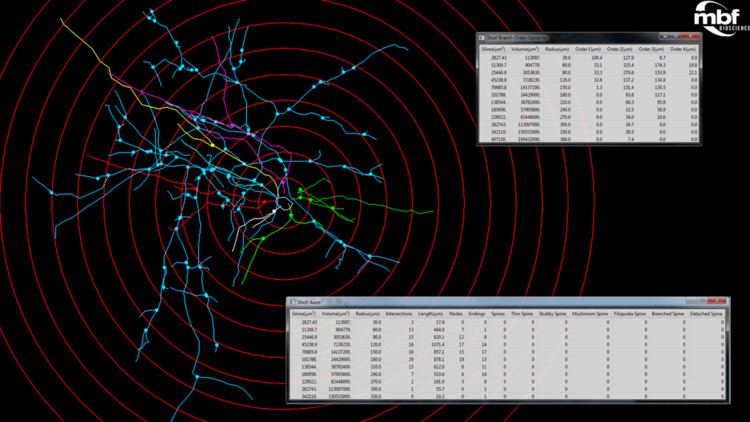 | ||
Sholl analysis is a method of quantitative analysis commonly used in neuronal studies to characterize the morphological characteristics of an imaged neuron, first used to describe the differences in the visual and motor cortices of cats. Initial quantification of a neuron is performed by counting the number of dendrite intersections for concentric circles, usually centered at the centroid of the cell body, of gradually increasing radius. Curves produced by this initial counting are usually of somewhat irregular shape, and much work has been done to determine appropriate means of analyzing the results. Common methods include Linear Analysis, Semi-log Analysis and Log-Log Analysis
Contents
Linear Method
The Linear Method is the analysis of the function N(r), where N is the number of crossings for a circle of radius r. This direct analysis of the neuron count allows the easy computation of the critical value, the dendrite maximum, and the Schoenen Ramification Index.
Critical Value: The critical value is the radius r at which there is a maximum number of dendritic crossings, this value is closely related to the dendrite maximum.
Dendrite Maximum: This value is the maximum of the function N(r), as specified by the Critical Value for a given data set.
Schoenen Ramification Index: This index is one measure of the branching of the neuronal cell being studied. It is calculated by dividing the Dendrite Maximum by the number of primary dendrites, that is, the number of dendrites originating at the cell's soma.
Semi-Log Method
Somewhat more complicated than the Linear Method, the Semi-Log Method begins by calculating the function Y(r) = N/S where N is the number of dendrite crossings for a circle of radius r, and S is the area of that same circle. The base 10 logarithm is taken of this function, and a first order linear regression, linear fit, is performed on the resulting data set, that is
where k is Sholl's Regression Coefficient.
Sholl's Regression Coefficient is the measure of the change in density of dendrites as a function of distance from the cell body. This method has been shown to have good discrimination value between various neuron types, and even similar types in different regions of the body.
Log-Log Method
Closely related to the Semi-Log Method, the Log-Log Method plots the data with the radius plotted in log space. That is the researcher would calculate the value k and m for the relation
This method is used in a manner similar to the Semi-Log Method, but primarily to treat neurons with long dendrites that do not branch much along their length.
Modified Sholl Method
The Modified Sholl Method is the calculation of a polynomial fit of the N and r pairs from the Linear Method. That is, it attempts to calculate a polynomial such that:
where t is the order of the polynomial fit to the data. The data must be fit to each of these polynomials individually, and the correlation calculated in order to determine the best fit. The maximum value of the polynomial is calculated and used in place of the Dendrite Maximum. Additionally, the average of the resulting polynomial can be determined by taking its integral for all positive values represented in the data set (most data sets contain some zero values).
Drawbacks
Sholl analysis is used to measure the number of crossings neurites make at different distances from the centroid, and is a type of morphometic analysis. It is primarily used to measure arbour complexity. Certain morphologies cannot however be indexed using Sholl alone. For instance, dendrite thickness cannot be measured. Dendrite length also cannot be determined, since dendrites do not necessarily emanate radially from the soma; dendrites can curve, cross the same circles multiple times, or extend tangentially and not cross at a circle at all. Additionally, Sholl analysis can be time consuming, and automated analysis software is limited.
Neurite ramification and Sholl analysis
Using the Sholl analysis, a mathematical algorithm named the branching index (BI) has been described to analyze neuronal morphology. The BI compares the difference in the number of intersections made in pairs of consecutive circles of the Sholl analysis relative to the distance from the neuronal soma. The BI distinguishes neurons with different types of neurite ramification.
Software
Several software packages perform Sholl analysis, namely those dedicated to neuronal tracing. An open-source implementation for the image processing package Fiji can be used to perform the analysis directly from microscope imagery of neurons or their traced reconstructions.
In modern implementations, analysis is performed in three dimensions: concentric shells are nested around a centre, and a surrogate of neurite mass (e.g., number of intersections, or total neurite length) contained within each shell is reported. Such software is amenable to high-throughput studies .
